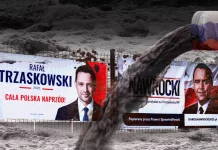
Thank you Mr. Chairman.
First, a disclaimer: the testimony I am about to give will be given in my capacity as a private expert and not as a Governor of the Broadcasting Board of Governors.
Mr. Chairman, the Ranking Member, Members of the Committee:
The aggressive, often sophisticated and Internet-savvy propaganda campaign, underwritten by the Russian government to the tune of at least half a billion dollars a year, is flexible and skillfully adapted to the geography of the audience. While general patterns are similar and I will discuss them in a moment, content may differ considerably depending on the ethnicity, political culture and geography of the intended audience.
Thus, in Western Europe and the United States, the RT television network aims not so much to “sell” what might be called the “Russia brand,” but rather to devalue the notions of democratic transparency and accountability, to undermine confidence in objective reporting, and to litter the news with half-truths and quarter truths.
“Question more!” is RT’s advertising motto – and it is not coincidental. For the Russian network seeks to exploit several key conventions and tendencies of Western media:
- First, truth is in the eye of the beholder. As a keen and formerly inside observer of the Russian media effort put it, Russian propaganda uses “the idea of a plurality of truths to feed disinformation, which in the end looks to trash the information space.” [1]
- Second, that there are two sides to every story, and the credibility of the source is secondary.“The medium is the message,” Marshall McLuhan famously proclaimed in the 1960s. Half a century later, the message is increasingly detached from the medium, and words from those who utter them. After all, post-modernism postulates that “there is no author, there is only the text.” My favorite modern English poet, Robert Graves, started the poem, titled “Forbidden Words,” with these four lines:“There are some words [that] carry a curse with them:
Smooth-trodden, abstract, slippery vocables.
They beckon like a path of stepping stones;
But lift them up and watch what writhes or scurries!”But when showered by these smooth-trodden and slippery vocables, how often do Western media bother to lift the stones? - Third, since the credibility of the source is of secondary importance, Russian propaganda finds itself fitting rather smoothly into a panoply of Western media. (Just to be on the safe side, RT, which does not broadcast in Russian, never identifies itself as a Russia-based and government-funded network.)
- Fourth, RT and the Sputnik news network, launched last year, find the soil of the Western media markets already fairly loosened and fertilized as far as conspiracy theories are concerned. Did the US government orchestrate 9/11? Why not? 23 percent of Germans thought so, as did 15 percent of Italians. [2] Seven years after the fall of the Twin Towers, between a quarter and one-fifth of Britons, French and Italians told the pollsters they had no idea who was behind the attack. [3] Well, then, after the CEO of France’s largest oil company, Total, who had opposed economic sanctions on Russia, was killed when his plane slammed into a snowplow operated by a drunken driver at a Moscow airport, Russian commentators asserted that he was killed by the CIA. [4] And why stop there? Did the CIA aid Ukrainians in shooting down the MH 17 Malaysian airliner (one of the “versions” suggested by Russian propaganda)? Plausible. Did the Russian opposition kill its own leader, Boris Nemtsov, to embarrass Putin? Possible.
- Fifth, with all the so-called value judgments to be taken out of the reporting, there are no more “just” wars or wars of “aggression” — only “conflicts.” Just as there are no “victims” and “perpetrators,” only “violence.” So when RT and Sputnik editors read or see or hear news in the leading Western media about “renewed violence” in the “conflict” between Ukraine and Russia, they find it easy to build up on and extrapolate from them to twist the truth. Especially, when almost one in three Germans was reported last summer to find Russia not responsible for the violence in Ukraine, that’s another opening for RT to exploit.
*
Yet for all this seemingly fertile soil for Russia’s distortions, the impact of the Russian disinformation campaign on the democracies of Western and Central Europe appears paltry, if not to say negligible. Where the ratings were credibly established, RT was barely visible, apart from the “pre-sold” audiences on the extreme left and right. [5] The main reason is a highly competitive media environment that exposes people to a wide range of facts and interpretations.
The situation is quite different when we go east, to the countries collectively known as the Former Soviet Union. There the effectiveness of Russian propaganda is greatly enhanced by two factors. First, the presence of ethnic Russian minorities, some of whom nurture grievances; and, second, the existence of far fewer alternative sources of credible information than in West-Central Europe.
It is here that what is known as the “weaponization of information” occurs: news and analysis as a means of provoking strong negative emotions, potentially leading to hatred, incitement and, ultimately, the justification of violence.
A couple of months ago, while searching Russian-language sites for information on the growing presence of Russian fighters with ISIS in Syria, I was directed by one of the links to one of Russia’s most popular sites, an equivalent of Facebook called VKontakte, which has hundreds of thousands of visitors each day both from Russia and the Former Soviet Union. Before I could get to the articles I was looking for, I saw pictured at the top of the opening page a cartoonish Uncle Sam holding on his lap a baby clad in a black uniform with a Kalashnikov on its back. The caption read: “ISIS is a project of America’s two-party system.”
As an expert on Russian propaganda in Estonia put it, this effort has produced “a separate reality created by Russian media” in which he claims many ethnic Russian Estonians already live and which creates enormous problems for democratic politics.
In Kyiv earlier this year one of my most memorable meetings was with the Dean of the School of Journalism at the Kyiv-Mohila Academy, Professor Evhen Fedchenko. Together with his students he runs a website called StopFake.org, which records some of the Russian propaganda masquerading as news. Here are a few examples:
- A report in the Russian media that the U.S. President has extended a decree that bans balalaikas (which are traditional Russian musical instruments) in the United States until 2020.
- Russia’s most widely watched Pervyi Kanal, or First Channel, television network, broadcast an interview with a terrified woman identified as a refugee from the territory controlled by the Ukrainian government. She said she witnessed Ukrainian soldiers publicly executing the wife and son of a pro-Russian separatist. The child was crucified on a bulletin board, while the woman was allegedly dragged behind a tank until she died. The story was proven to be a complete fake.
Another popular Russian television channel posted on VKontakte and other social media sites an invented conversation between a Ukrainian military commander and a German doctor in which they discuss in detail the harvesting of internal organs, presumably of deceased members of the pro-Russian population caught up in the fighting. The officer is “quoted” as saying that “we would have a great deal of material to work with, thanks to our Western partners.”
Again, bear in mind that Russian television, especially the news programs I just mentioned are viewed by millions of people, especially ethnic Russians and Russian-speakers, outside Russia.
*
Fortunately, there is an antidote to this poison. It is impossible, of course, to sanitize all of the lies, given the lopsidedness of the manpower, but there is enough of it to deflate the effort considerably.
As usual, the strongest antidote is a rich, diverse, and uncensored democratic media environment. But as such an environment does not yet fully exist in most post-Soviet states, the U.S. international media effort could be of great help.
Despite being barred from domestic outlets in Russia, the online audience of Radio Free Europe/Radio Liberty and Voice of America online has been growing, reaching 4.7 million this summer. In my office last week, a top Russian pro-democracy leader, Vladimir Milov told me that “Radio Liberty is by far the finest and most influential of unofficial sources of political information and analysis in Russia today!” According to independent research, nearly two million Russians are watching RFR/RL’s flagship 30-minute nightly news program Nastoyashchee vremya or Current Time online every week.
Last year, a nation-wide Gallup survey in Ukraine showed that the size of the VOA audience across all of its media platforms in the Ukrainian and Russian languages had doubled since 2012 to nearly 7 million adults using VOA every week – that is 18 percent of all adults in Ukraine plus nearly 3 million using RFE/RL.
In Kyiv I was repeatedly struck by the deep appreciation by Ukraine’s political and media elites of the content provided by Radio Liberty. RFE/RL content is being recognized as superior not just to the Russian propaganda but, to the output of the oligarch-dominated Ukrainian media, which is just as important. As a result, several top Ukrainian television networks competed for the prime time broadcast rights for Current Time.
Mr. Chairman, we are facing a determined and often refined propaganda effort. From the sophisticated exploitation of Western media patterns and vocabulary to outright lies and crude fakes, the goal remains the same: to undermine the people’s trust in democratic politics and policies and in free and fair media. As this effort is vital to the maintenance of the present Russian regime, it will be with us for a long time.
Time, and, talent, and risk-taking innovation and yes, money for US international media will continue to be needed to counter it.
Thank you.
1. Stephen Castle, “A Russian TV Insider Describes a Modern Propaganda Machine,” New York Times, February 13, 2015.
2. “International Poll: No Consensus on Who Was Behind 9/11.” World Public Opinion, September 10, 2008.
3. Ibid.
4. Alan Cullison, “Russia Uses MH17 Crash for Propaganda,” Wall Street Journal, July 23, 2015.
5. The Daily Beast reports that in 2012, RT’s daily viewership did not reach the minimum Nielsen rating threshold of 30,000 people in the United States, and that in Europe, its audience has amounted to less than 0.1 percent of total viewership, except in Britain where it does slightly better, garnering 0.17 percent of the total viewing population in 2015. RT’s oft-cited figure of “630 million people in 100 countries” refers to the potential geographical reach of its programming based on where RT is available—not on how many people are actually viewing it.
By Leon Aron, American Enterprise Institute
Leon Aron is Resident Scholar and Director of Russian Studies





